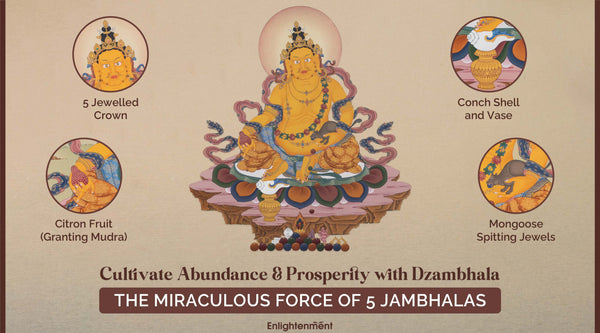Beyond Ordinary: Exploring the Marvels of Virupa and Spirituality
Virupa is a prominent figure in Buddhist history, renowned as a mahasiddha of great repute. He secures his place in the esteemed assembly of the 84 Mahasiddhas, a compilation curated by Abhayakirti. Notably, he finds his position within the lineage of Dorje Shugden's incarnations, signifying his connection to one of Dorje Shugden's preceding lifetimes. Yet, like numerous other mahasiddhas, Virupa's appellation emerged after he attained 'siddhis' or profound realizations.
Birth Of The Mahasiddha 
Click here to view our Mahasiddha Virupa Thangka
Virupa was born around the 7th-8th century to King Suvarnachakra's royal lineage in the ancient city of Vesasa, located in the eastern expanse of India. Upon his birth, the infant underwent scrutiny by the court astrologers, who deciphered auspicious marks and omens. These signs pointed to his destined acquisition of profound spiritual prowess and his future role in propagating the Buddha's teachings.
Thus, he received the appellation Rupyachakra. Guided by the interplay of karma and his resolute predisposition, he ventured into the esteemed halls of the grand Somapura monastery in North Bengal. Under the tutelage of Abbot Vinitadeva and Acharya Jayakirti, he embraced ordination, marking the initiation of his spiritual journey.
Ordination At Shri Nalanda
During that era, Shri Nalanda University stood as the preeminent seat of learning, encompassing the entirety of the four schools of Buddhist philosophy. Within its revered walls, Virupa entered, undertaking full ordination vows under the guidance of Abbot Dharmamitri from the Mulasarvastivada School.
Assuming the ordination name Shri Dharmapala, he also received profound Chakrasamvara teachings and instructions from the same Abbot. Following his mentor's parinirvana, Virupa ascended to the prestigious position of the Great Abbot, presiding over all scholars at Nalanda University.
Life Changing Dream and Realizations
Virupa diligently engaged in the practice of Chakrasamvara during the nocturnal hours, while his days were occupied with instructing in the Sutrayana, engaging in debates, and crafting Dharma texts. He dedicated himself to this routine for numerous years but with no signs or achievements. Instead, he encountered a series of unfortunate events that left him disheartened in his pursuits.
In a state of disillusionment, Virupa concluded that his current life lacked a connection to the concealed path of Mantrayana. Resolving to redirect his efforts, he immersed himself exclusively in studying and contemplating the standard vehicle.
Firmly, he committed to refraining from teaching the Dharma, composing sacred texts, and partaking in yidam practices. This decisive shift in approach culminated on the 22nd of the fourth lunar spring month (Vesak) when he symbolically discarded his mala into a toilet, signifying his abandonment of the practice and his intention to adopt a more relaxed stance.
Conselling By Nairatmaya
However, fate had other plans. That very night, a transformative dream visited him. In this dream, Nairatmaya manifested as an ordinary blue lady, conveying her message with gentle authority. She addressed him as "Noble Son" and implored him to reconsider his actions, advocating against misguided conduct.
Her counsel was precise: "he would retrieve his mala, cleanse it in fragrant water, acknowledge his misstep, and commit to a corrected course". With emphasis, she disclosed herself as the deity intertwined with his karmic destiny, bestowing a cascade of blessings that would propel him toward swift accomplishments. And then, as suddenly as she appeared, she dissolved from the dream's canvas.
Enlightenment Of the Deity
The following day, upon awakening, Virupa was consumed by profound remorse. On the 23rd day of the lunar month, he retrieved his mala and meticulously adhered to the guidance imparted within his dream.
During that night, he was granted a vision of primordial wisdom, manifested through the intricate assembly of fifteen goddesses within the mandala of Nirmanakaya, personifying Nairatmaya. In this ethereal encounter, he underwent the complete bestowal of the four empowerments, culminating in attaining the first bhumi, or stage of enlightenment, by dawn's first light.
Significance in Tibetan Buddhism
Virupa's significance in the rich history of Tibetan Buddhism is immense. His teachings, which are renowned for being direct and immediate, are consistent with the fundamental ideas of the Vajrayana tradition. Virupa's life story, which is filled with daring deeds and innovative ways, serves as a reminder that enlightenment is not only possible via firsthand encounters with life's chaos but also through monastic solitude.
Teachings that Transcend Time
The teachings of Virupa are out of the ordinary and frequently contradict conventional wisdom. His wisdom stands out because he strongly focuses on firsthand insight and realization. He felt that one could achieve enlightenment by fully accepting the present moment. The legacy of the deity emphasizes the possibility of discovering important truths even amid chaos.
Virupa's impact has been felt through the ages, and his teachings are reflected in the rituals of many different spiritual individuals. His fearless approach to overcoming restrictions and accepting the whole range of human experience resonates with modern mindfulness practices. Beyond spirituality, his impact transcends forms of creative expression as artists are inspired by his quest to push boundaries.
Iconography in Thangka
-
Central Figure
Mahasiddha Virupa is frequently shown as the thangka's central figure. He is depicted in a calm sitting position that might be full or half lotus. His demeanor of nobility and serenity conveys his high level of spiritual development. -
Physical Appearance
He is usually portrayed as having a monastic aspect and wearing simple clothing to symbolize his rejection of worldly attachments. He might have a shaved head to emphasize his status as a renunciate. -
Hand Gesture/ Mudra
The deity appears, raising his right hand, his index finger pointing upward, and his left hand resting on his lap. This is one of his most recognizable mudras. This action represents his strength and capacity to get beyond challenges on the spiritual path. He occasionally holds a skull cup filled with various symbolic substances in his right hand to symbolize his control over inner and outward aspects. -
Accessories
Necklaces, bracelets, and earrings are just a few examples of the ornaments and jewelry that Virupa frequently wears. These decorations stand for his accomplishments and skill. -
Background
The thangka's background may feature symbolic or real-world scenes from Virupa's life. This might depict him working miracles, interacting with regular people, or practicing meditation. -
Symbolism
The thangka may have symbolic components to convey underlying meanings. For instance, Virupa's representation can include several animals, each representing a distinct stage of his spiritual development. As a representation of his metamorphosis and realization of enlightenment within the crucible of experience, he might also be encircled by flames or a mandala.
The thangka's design is meticulously planned to highlight Virupa's spiritual presence and rank as a respected mahasiddha. His posture, demeanor, and general behavior would be evaluated to indicate his inner wisdom and enlightenment.
The instantaneous nature of experience is emphasized in Virupa's teachings. His innovative approaches disrupted preconceived beliefs and encouraged in-depth reflection, inspiring both amazement and controversy. Virupa was unconventional in his thinking, and his legacy is anchored in the changes he sparked in those who were fortunate enough to cross his path.


